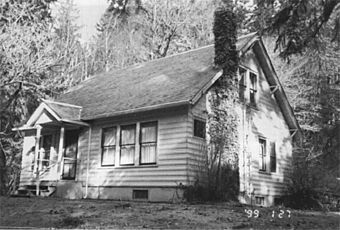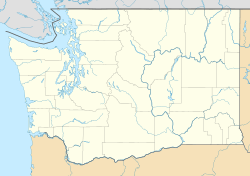Elwha Ranger Station facts for kids
Quick facts for kids |
|
|
Elwha Ranger Station
|
|
 |
|
| Location | Along Elwha River, about 3 miles (4.8 km) south of Elwha, in Olympic National Park |
|---|---|
| Area | 9 acres (3.6 ha) |
| Architect | U.S. Forest Service |
| Architectural style | Bungalow/Craftsman |
| MPS | Olympic National Park MPS |
| NRHP reference No. | 07000716 |
| Added to NRHP | July 13, 2007 |
The Elwha Ranger Station is a special historical area located in Olympic National Park. It was first built in the 1930s by the United States Forest Service. This site has many buildings that were used by park rangers and staff.
The station has fourteen buildings in total. They are split into two groups by the Olympic Hotsprings Road. On one side, you'll find the main ranger station and three homes. On the other side, there are nine buildings used for maintenance and repairs.
In 1940, the land became part of Olympic National Park. The National Park Service then took over the Elwha Ranger Station. The buildings were designed in a style called Bungalow or American Craftsman. This was a popular building style for the Forest Service back then.
The Elwha area was chosen as a spot for people to enjoy nature. A plan called the "Cleator Plan" suggested building things like a ranger station here. In the mid-1930s, a group called the Civilian Conservation Corps (CCC) helped build many parts of the station. The CCC was a program that gave young men jobs during the Great Depression. Even after the National Park Service took over, the station kept its original look and feel.
Contents
What Buildings Are at Elwha Ranger Station?
The Elwha Ranger Station is a historic district because it has 13 important buildings. These buildings were all constructed between 1930 and 1936.
Main Buildings for Rangers and Staff
- Elwha Ranger Station Office: This building was made in 1932. It's a one-story wooden building with special half-log siding. It has porches on two sides, held up by log columns. This is where the rangers would have done their office work.
- Ranger Station Residence: Also built in 1932, this was a home for a ranger. It's a 1.5-story building, similar to the office in how it was built.
- Mechanic's House: This house was built a bit earlier, in 1930. It's also a 1.5-story building, much like the others. A small woodshed is located nearby.
- Bunkhouse: Built in 1932, this building was a place for workers to sleep. It's a 1.5-story building, similar to the other homes, and has its own woodshed.
Maintenance and Support Buildings
Across the road from the main offices and homes, you'll find the maintenance area. These buildings helped keep the park running smoothly.
- Fire Cache Building: Built in 1930, this wooden building stored tools and equipment for fighting fires.
- Equipment Sheds: There are a few of these. One was built in 1930, and another in 1936. The 1936 shed was actually moved here in 1948 from a nearby CCC camp. These sheds stored park equipment.
- Equipment Repair Shop: This is where park staff would fix and maintain vehicles and tools. It was built in 1930.
- Horse Barn: Also built in 1930, this two-story barn housed horses used by the Forest Service. It has a unique look with vertical wooden siding.
- Gas and Oil Building: Built in 1936 by the Civilian Conservation Corps, this building stored fuel and lubricants. It looks a bit like a small house, with decorative pine tree shapes in its gables.
- Lean-to Shed: A smaller shed built in 1936, likely for extra storage.
Why is Elwha Ranger Station Important?
The Elwha Ranger Station complex was added to the National Register of Historic Places on July 13, 1997. This means it is recognized as a very important historical site. It helps us understand how national parks were managed and built in the early 20th century. The district is located near other historic sites in Olympic National Park, like the Elwha and Altair community kitchens.


